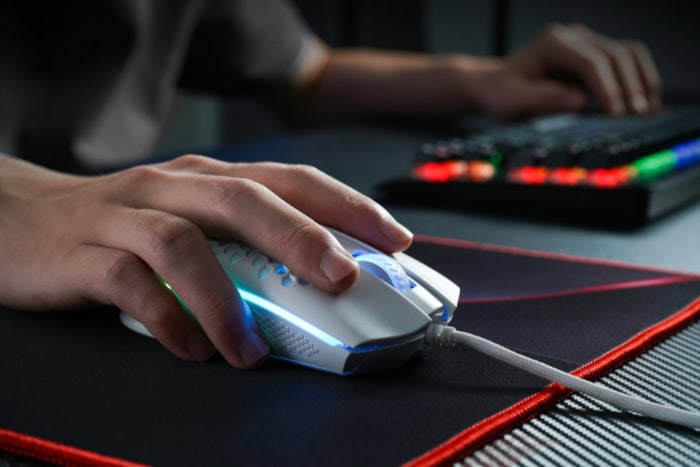What Is Mouse Acceleration and How to Disable It

Mouse acceleration might seem like a small detail in your computer's settings, but it significantly impacts how you interact with your device. This subtle feature adjusts your cursor's speed based on how quickly you move your mouse – a faster physical movement results in the cursor traveling proportionally further across your screen.
While this can make everyday computing feel smoother for casual users, it often frustrates gamers and creative professionals who need precise, predictable cursor movements.
Understanding Mouse Acceleration
Mouse acceleration modifies cursor movement based on the speed at which you physically move your mouse. Unlike standard mouse movement, where the cursor travels a fixed distance relative to mouse movement, acceleration creates a variable relationship.
For example, moving your mouse slowly for one inch might move the cursor 100 pixels, while quickly moving it the same distance could move the cursor 300 pixels or more.
Operating systems implement this feature to help users navigate larger screens more efficiently. The concept behind it is simple: when you move your mouse quickly, you likely want to cover more screen distance, and when you move it slowly, you probably need more precision.
This variable response aims to provide both quick navigation and precise control within a single setting.
Implementation Across Systems
Mouse acceleration became standard across operating systems, with each platform developing its own implementation. Windows uses a feature called “Enhance Pointer Precision,” while macOS includes it as part of its mouse tracking speed settings.
Over time, these implementations have become more sophisticated, incorporating complex algorithms to predict user intent and adjust cursor movement accordingly.
The technology has evolved significantly from its original form. Modern mouse acceleration takes into account factors such as DPI (dots per inch) settings, screen resolution, and even the specific applications being used.
Gaming mice manufacturers have also developed their own acceleration curves and customization options, allowing users to fine-tune their experience beyond operating system defaults.
These developments reflect the ongoing balance between providing intuitive navigation for casual users while maintaining options for those who require precise control.
Despite its widespread implementation, the gaming community has largely moved away from mouse acceleration, preferring the predictability of raw input for competitive play.
Benefits and Drawbacks of Mouse Acceleration
Mouse acceleration presents a mixed bag of effects on user experience, varying significantly based on how you use your computer. From casual browsing to intense gaming sessions, its impact can be either helpful or hindering, making it crucial to evaluate both sides of this feature.
Positive Aspects of Acceleration
Mouse acceleration offers several advantages for everyday computer users, particularly those working with large or multiple displays.
The dynamic cursor speed allows users to traverse wide screen spaces with minimal physical mouse movement, reducing wrist strain and desk space requirements.
For instance, a quick flick of the wrist can move the cursor from one corner of the screen to another, while maintaining the ability to make precise movements when needed.
Office workers and casual users often benefit from acceleration while performing routine tasks like document editing or web browsing. The variable cursor speed makes it easier to switch between windows or monitors without constantly repositioning the mouse.
This efficiency becomes particularly noticeable on high-resolution displays, where covering large screen distances would otherwise require multiple mouse movements.
Performance Limitations and Issues
Despite its benefits for casual use, mouse acceleration introduces several significant drawbacks, particularly in scenarios requiring precise cursor control.
Gamers and digital artists often find that acceleration interferes with their ability to build consistent muscle memory.
The variable cursor movement makes it challenging to replicate the same action repeatedly, as identical physical movements can result in different cursor positions depending on speed.
In competitive gaming environments, this inconsistency can be particularly problematic. Players attempting to aim in first-person shooters or make precise selections in strategy games may find their accuracy compromised.
The acceleration curve can cause overshooting targets or missing crucial clicks, especially during high-pressure situations where quick reactions are essential.
The impact on muscle memory extends beyond gaming. Graphic designers and video editors who require pixel-perfect precision often struggle with acceleration enabled.
The varying cursor speeds can make it difficult to develop the fine motor control needed for detailed work.
Professional users frequently report that disabling acceleration allows them to work more efficiently and accurately, as they can better predict exactly where their cursor will land based on physical mouse movement.
Additionally, acceleration can create problems when switching between different computers or setups. Since each operating system and device may implement acceleration differently, users might find their cursor behavior inconsistent across various machines.
This variability can be particularly frustrating for professionals who work on multiple systems or gamers who compete on different setups.
Mouse Acceleration in Gaming

Gaming represents one of the most demanding use cases for mouse control, where every millisecond and pixel of movement can make the difference between victory and defeat.
The gaming community has developed strong preferences regarding mouse acceleration, with most competitive players opting to disable this feature entirely.
The Critical Role of Consistent Aim
Competitive gaming demands exceptional precision and reproducible movements. Players need to build reliable muscle memory for actions they'll repeat thousands of times, such as flicking to an enemy's head in a first-person shooter or selecting units in a real-time strategy game.
Raw, consistent mouse input allows gamers to develop these skills through repetition and practice.
Without acceleration, moving your mouse a specific distance will always result in the same cursor movement on screen. This predictability becomes crucial during intense gaming moments where split-second decisions and precise movements determine success.
For example, a Counter-Strike player needs to know exactly how far to move their mouse to turn 180 degrees or adjust their aim by a few pixels, regardless of how quickly they execute the movement.
The development of muscle memory relies heavily on this consistency. Professional players often spend hours practicing specific movements and angles, creating a physical memory of exactly how far to move their mouse for particular actions.
Mouse acceleration disrupts this learning process by introducing variable movement speeds, making it harder to build reliable mechanical skills.
Elite Players and Their Setup Choices
Professional gamers almost universally disable mouse acceleration, treating raw mouse input as a fundamental requirement for competitive play. This preference is reflected in tournament settings, where acceleration is typically disabled by default on competition computers.
Many top-tier players share their exact mouse settings with fans, revealing a common thread: acceleration is consistently turned off. For example, professional CS:GO players typically use a combination of low DPI (400-800) and raw mouse input without acceleration.
Popular streamers and pro players often emphasize the importance of these settings in their tutorials and setup guides.
Tournament organizers have recognized this preference, implementing standardized mouse settings across competition machines.
Major esports events ensure that all players can disable acceleration and use their preferred mouse settings, acknowledging how crucial these configurations are to performance.
The impact of these preferences extends beyond just professional play. Amateur players and aspiring competitors frequently emulate pro settings, leading to a widespread adoption of acceleration-free setups throughout the gaming community.
Gaming peripheral manufacturers have responded by creating mice with dedicated buttons to toggle DPI settings and built-in memory to store raw input preferences, catering to players who want consistent performance across different computers.
These choices reflect a broader philosophy in competitive gaming: removing variables that could introduce inconsistency in player performance. Just as professional athletes carefully select their equipment, esports players view their mouse settings as essential tools that must be precisely tuned for optimal performance.
How to Disable Mouse Acceleration

Disabling mouse acceleration requires different approaches depending on your operating system. While the process might seem technical at first, following the correct steps will help you achieve consistent mouse movement across all your applications and games.
Windows 11 Configuration Guide
Method 1: Through Settings
- Press Windows + I to open Settings
- Click “Bluetooth & devices” in the left sidebar
- Select “Mouse”
- Click “Additional mouse settings”
- In the new window, select “Pointer Options” tab
- Uncheck “Enhance pointer precision”
- Click “Apply” then “OK”
- Restart your computer
Method 2: Quick Access
- Type “Mouse settings” in the Windows search bar
- Click “Mouse settings” from results
- Follow steps 4-8 from Method 1
Windows 10 Configuration Guide
Method 1: Through Settings
- Open Start Menu
- Click the gear icon (Settings)
- Select “Devices”
- Click “Mouse” in the left sidebar
- Click “Additional mouse options”
- Select “Pointer Options” tab
- Uncheck “Enhance pointer precision”
- Click “Apply” then “OK”
- Restart your computer
Method 2: Control Panel
- Right-click Start Menu
- Select “Control Panel”
- Click “Hardware and Sound”
- Select “Mouse” under Devices and Printers
- Follow steps 6-9 from Method 1
macOS Configuration Guide
Method 1: System Settings (macOS Sonoma)
- Click the Apple menu in the top-left corner
- Select “System Settings”
- Go to “Mouse”
- Click “Advanced”
- Set “Pointer acceleration” to off
- Close System Settings
Method 2: Terminal Command (All macOS Versions)
- Open Terminal (Applications > Utilities > Terminal)
- Copy and paste this command: defaults write .GlobalPreferences com.apple.mouse.scaling -1
- Press Enter/Return
To Restore Default Settings:
- Open Terminal
- Enter the command: defaults write .GlobalPreferences com.apple.mouse.scaling 1
Note: The Terminal method provides a more complete removal of acceleration and works across all macOS versions, while the System Settings method might vary slightly depending on your macOS version.
Conclusion
Mouse acceleration remains a personal choice that depends heavily on your computing needs. Gamers and creative professionals often benefit from disabling it, gaining precise control and consistent cursor movement for their specialized tasks.
Regular computer users might prefer keeping acceleration enabled for comfortable navigation across larger screens. With simple steps to modify these settings in Windows, you can experiment with different configurations to find what works best for you.
Remember that muscle memory adapts to whatever setting you choose, so give yourself time to adjust after making changes. Most importantly, your mouse settings should enhance your workflow and gaming experience, not hinder them.


